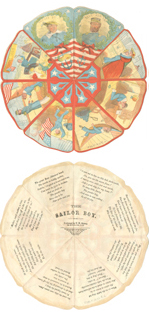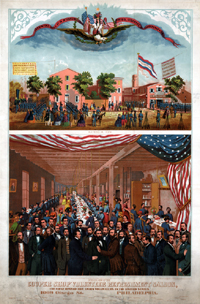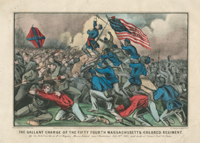The John A. McAllister Collection: Graphics

Recto and verso of The Sailor Boy. (New York: Published by T.W. Strong, no. 98 Nassau St., c1864). Chromolithograph.
The McAllister Graphics Collection includes the work of near a dozen early Philadelphia photographers that documents the city between 1844 and circa 1870. Daguerreotypes, paper photographs, stereographs, and cartes de visite, by pioneer photographers such as the Langenheims, Frederick De Bourg Richards, and James McClees, form the core of the early photograph collections within the department. Work by the Langenheims includes the “first news photograph” of Philadelphia , a daguerreotype of Girard Bank during the Nativist Riots of 1844, and photographs issued circa 1855-circa 1862 that show business interiors, panoramic views of the city, Fairmount Park, and scenes along the Delaware Riverfront.
1322-F-40g_sm.jpg)
Malachy's Church, 1429 North 11th Street, Philadelphia.(Philadelphia: McAllister & Brother, December 25, 1860). Albumen on stereograph mount.
Some of the oldest photographic views of Philadelphia church exteriors and interiors represent another noteworthy segment of photographs in the McAllister Graphics Collection. Issued as stereographs circa 1860-circa 1863 by McAllister & Brother, the photographs provide images of such prominent religious structures as Christ Church, St. Peter’s Church, Gloria Dei, and St. Mark’s Church. Other stereographs included in the McAllister Graphics Collection are views of Chestnut Street published by Bartlett & French and Bartlett & Smith; views of Lincoln’s funeral and hometown photographed by Schreiber & Glover; and interiors of the Union League.
1322-F-7e_sm.jpg)
W. & F. Langenheim. Interior view of McAllister & Brother's Opticians' Shop, 194 Chestnut Street, Philadelphia, ca. 1855. Albumen print.
Published prints including engravings, lithographs, and relief prints form another large segment of the McAllister Graphics Collection. Nineteenth-century business advertisements, portraiture, political cartoons, cityscape and landscape views, predominately published in Philadelphia, New York, Boston, and London, constitute the majority of the prints. A substantial portion visually documents Philadelphia. Near a hundred are illustrations clipped from guidebooks, city directories, and periodicals showing city businesses, industries, churches, benevolent and educational institutions, and public buildings.
The 1856 prospectus for and plates from the 1859 “Baxter’s Panoramic Business Directory of Philadelphia” provides another interesting example of views of Philadelphia included in the collection. Published by engraver Dewitt C. Baxter the prints show storefronts on blocks of Chestnut, Third, and Market streets complemented by advertisements for the depicted businesses. In addition, reprints from original plates of William Birch’s “Views of Philadelphia” and “County Seats” published in 1860 by John A.’s father, John McAllister Jr., showcases the collector’s reverence for local history.
1322-F-130c_sm.jpg)
Frederick De Bourg Richards, Library Street, Southside, between Goldsmith's Hall and Fourth Street, ca. 1859. Salted paper print.
The McAllister Graphics Collection also contains about 100 eighteenth and nineteenth-century maps. The maps primarily document Philadelphia and Pennsylvania, in addition to North America, including specific U.S. states and Canada. Street, ward, property, and railroad route maps comprise the majority of the content of the cartography. Other subjects include navigational charts; plans of the 1864 Philadelphia Sanitary Fair and 1893 World Columbian Exposition; Benjamin Franklin’s chart of the Gulf Stream; and several Civil War campaign and battle maps. Another map of note within the collection is the circa 1833 “Map of the West Coast of Africa, from Sierra Leone to Cape Palmas, including the Colony of Liberia. Complied chiefly from the surveys and observations of the late Revd. J. Ashman [sic]” showing the free black emigrant colony founded after 1822 by Ashmun, a member of the American Colonization Society.

Morris H. Traubel, Cooper Shop Volunteer Refreshment Saloon, the First Opened for Union Volunteers in the United States. 1009 Otsego St. Philadelphia. (Philadelphia : Chromolithography of M. H. Traubel, 409 Chestnut St., 1862). Copyrighted by Wm. M. Cooper, C.V. Fort & Co., (i.e., Cooper Shop Volunteer Refreshment Saloon Committee). Chromolithograph.
Also significant is the Civil War ephe mera, which includes envelopes, stationery, and paper novelties such as toy soldiers. The Civil War Envelope and Stationery collections contain over 7,000 items illustrated with patriotic designs and slogans. The designs depict portraits of historic and prominent military figures, military scenes, state seals, cartoons, Liberty, A merican eagles, flags, and other military and patriotic emblems. Several envelopes by prolific publishers King & Baird and Charles Magnus are included in this collection. A smaller ephe mera collection is the Civil War paper soldiers. The paper toys, a small number published by McLoughlin Bros. and G. Heerbrandt, depict soldiers from over a dozen different New York regi ments and are shown with guns, riding on horseback, and in the charge of battle.

The Gallant Charge of the Fifty Fourth Massachusetts (Colored) Regiment: On the Rebel Works at Fort Wagner, Morris Island near Charleston, July 18th 1863, and death of Colonel Robt. G. Shaw. (New York: Published by Currier & Ives, 152 Nassau St.,1863). Hand-colored lithograph.
The Civil War photographs primarily contain stereograph and cartes-de-visite series issued by the prominent Civil War photographers Mathew Brady, Barnard & Gibson, Alexander Gardner, and Levy & Cohen. The over 150 views principally depict the aftermath of Union campaigns in the South, including the fall of Richmond. Other significant series of Civil War-era photographs include images photographed by A. Watson of the Great Central Fair in Philadelphia, and interior views of the Union Volunteer Refreshment Saloon taken by Robert Newell. Cartes-de-visite caricatures satirizing military figures, battles, the home front, camp life, the Confederacy and African Americans are also a significant portion of the Civil War photographs. Three scrapbooks of Civil War envelopes and portrait prints and photographs of prominent military and political figures comprise the Civil War material in the McAllister Graphics Collection as well.
The McAllister Graphics Collection also contains the “European Views” and “Costume” scrapbooks. The former contains printed views and photographs of Europe that show city, land and seascapes of European countries including, England, France, Germany, and Italy. The latter contains nineteenth-century fashion plates and prints, dozens removed from R. Ackerman’s Repository of Arts, Literature, Commerce, Manufacturers, Fashions and Politics, of American and English costume.

1322-F-20_sm.jpg)